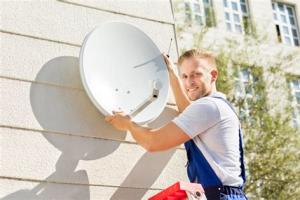The Complete Guide to Satellite Dish Installation: From Basics to Advanced Techniques

-
Quick Links:
- 1. Introduction
- 2. Understanding Satellite Dishes
- 3. Tools Required for Installation
- 4. Choosing the Right Location
- 5. Step-by-Step Installation Guide
- 6. Aligning Your Satellite Dish
- 7. Troubleshooting Common Issues
- 8. Case Studies
- 9. Expert Insights
- 10. FAQs
1. Introduction
Installing a satellite dish can seem like a daunting task, but with the right guidance, it can be a straightforward process. This ultimate guide will walk you through everything you need to know about satellite dish installation, from understanding the technology to troubleshooting common issues. Whether you are a beginner or have some experience, this guide will provide valuable insights and practical steps for a successful installation.
2. Understanding Satellite Dishes
A satellite dish is a type of antenna that receives signals from satellites orbiting the Earth. Here are the main components:
- Dish: The parabolic reflector that captures the satellite signal.
- LNB (Low Noise Block downconverter): The device that receives the signal from the dish and converts it to a lower frequency.
- Mount: The structure that supports the dish.
- Cabling: Coaxial cables that transmit the signal to your receiver.
3. Tools Required for Installation
Before you start the installation, gather the following tools:
- Drill with drill bits
- Screwdriver (Phillips and flathead)
- Level
- Measuring tape
- Socket wrench
- Compass or smartphone app for direction
- Coaxial cable and connectors
- Safety goggles
- Ladder
4. Choosing the Right Location
Choosing the right location for your satellite dish is crucial for optimal signal quality. Here are some factors to consider:
- Clear Line of Sight: Ensure there are no obstructions like trees or buildings between the dish and the satellite.
- Elevation: Higher elevations often provide better signal quality.
- Accessibility: Make sure you can easily access the dish for maintenance and adjustments.
5. Step-by-Step Installation Guide
Follow these steps for a successful satellite dish installation:
Step 1: Mounting the Dish
Use the mounting bracket to secure the dish to a pole or wall. Ensure it is level and tight. Use the drill to secure it into place.
Step 2: Connecting the LNB
Attach the LNB to the dish arm according to the manufacturer's instructions. Make sure it is properly aligned.
Step 3: Running the Cables
Run the coaxial cables from the LNB to your receiver inside the house. Secure the cables to prevent damage.
Step 4: Connecting to the Receiver
Connect the coaxial cable to the receiver. Ensure all connections are tight to prevent signal loss.
Step 5: Powering Up
Plug in your receiver and power it on. Follow the setup instructions on the screen to complete the installation.
6. Aligning Your Satellite Dish
Proper alignment is essential for receiving a strong signal. Follow these steps:
- Use a compass to find the direction of the satellite.
- Loosen the bolts on the dish mount to adjust the angle.
- Make small adjustments while monitoring the signal strength on your receiver.
- Once you find the optimal position, tighten the bolts securely.
7. Troubleshooting Common Issues
If you encounter issues with your satellite dish, consider the following troubleshooting steps:
- No Signal: Check for obstructions and ensure the dish is properly aligned.
- Weak Signal: Inspect the cabling for damage and ensure all connections are tight.
- Intermittent Signal: Look for loose connections or interference from nearby devices.
8. Case Studies
Case Study 1: Urban Installation Challenges
In urban areas, signal interference is common due to tall buildings. A homeowner in New York City successfully installed their dish on a rooftop, which provided a clear line of sight and improved signal quality.
Case Study 2: Rural Installation Success
A family in rural Texas faced challenges with trees obstructing their signal. By relocating their dish to a higher pole and clearing some branches, they achieved optimal reception.
9. Expert Insights
According to satellite installation expert John Smith, "Choosing the right location is half the battle. Make sure to assess your surroundings before mounting the dish."
For more in-depth insights, you can refer to Satellite Internet's Guide to Installation.
10. FAQs
1. How long does it take to install a satellite dish?
Installation typically takes 1-3 hours, depending on your experience and installation location.
2. Can I install a satellite dish myself?
Yes, with the right tools and guidance, many homeowners can successfully install a satellite dish themselves.
3. What if my dish is not receiving a signal?
Check the alignment, ensure there are no obstructions, and verify all connections are secure.
4. Do I need a permit to install a satellite dish?
Check with your local regulations. Some areas may require a permit for installation.
5. Can weather affect my satellite signal?
Yes, heavy rain, snow, or storms can temporarily affect signal quality.
6. What type of satellite dish should I get?
Your choice depends on your location and service provider. Consult your provider for recommendations.
7. Can I move my satellite dish once it’s installed?
Yes, but it may require realignment and adjustments to ensure optimal signal reception.
8. What tools do I need for installation?
You will need a drill, screwdriver, level, measuring tape, and coaxial cables.
9. Is professional installation recommended?
While DIY installation is possible, professional installation can ensure optimal performance and save you time.
10. How do I align my satellite dish correctly?
Use a compass to find the satellite direction and adjust the dish angle while monitoring the signal strength.
Random Reads
- Ultimate guide removing thinset
- How to destroy an old computer
- Deleting or deactivating skype account
- How to download files documents
- How to bluejack
- How to blow up tnt in minecraft
- An easy guide to drying wood at home
- Apple id sign out unavailable fix
- How to type letters with accents
- How to type pi symbol